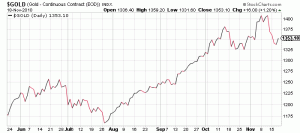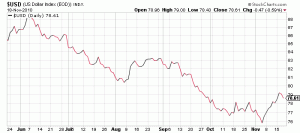Well QE2 arrived and just like the ship was pretty big, at $600billion was $100billion more than expected. As is often the case the initial news was met with euphoria but as markets tagged new highs for the year traders took the attitude that it is better to travel than arrive and took some money off the table. Will this spending be enough to accelerate what is a very sluggish recovery in the States? Only time will tell and all eyes will be on US unemployment numbers as the key indicator of whether or not the strategy is working. Following the shipping theme the latest Queen Elizabeth liner is bigger and uglier than the old one and not known as QE3 is this an omen?
What QE2 has done though is to intensify the currency war between the US and China. As we have mentioned in previous newsletters Quantative Easing is part of deliberate policy to weaken the Dollar and thus inflate the US economy. The major losers are those countries that export to the US. Through the export trade they end up holding large bank balances of US Dollars which go down in value as the Greenback falls. With a free floating currency this imbalance is naturally sorted by the other currency going up in value. But the Renmimbi is not free floating, it is set at an artificially low level to aid China’s industrial revolution.
The further consequence of this is that China, as the fastest growing major economy, is the most attractive place to invest hence benefits from a practice known as the “Carry Trade”. This trading strategy started in Japan in the 90’s, as the Japanese economy deflated interest rates fell to virtually zero. The big players could then borrow at minimal cost and buy high yielding assets elsewhere in the World and make a turn. The real beauty was that there was enough within this turn to be able to hedge the currency risk and end up with a minimal risk trade. This trade ended as US rates fell to Japanese levels. QE has however meant that the US Government is subsidising loans and the “Carry Trade” has moved to the US. Borrow cheaply in America, hedge the Dollar (as the default currency only way to hedge is with Gold) and invest the money in the highest yielding areas i.e. China and the Emerging markets.
Gold
Dollar
Gold is often described by many commentators as the ultimate investment the best hedge against a market sell-off and inflation. This not the case, any sign that US economic growth is accelerating will see the end of QE and cheap money and thus the end of the “Dollar Carry Trade” Dollar shorts will have to buy the Dollar and sell their holdings of Gold.
China as a beneficiary of this practice is in danger of becoming the victim of its own success as all this cheap money, unchecked by what should be a strong currency, stokes up inflation. Chinese inflation is much higher than in the Old World but that’s okay as long as in turn growth is higher still, which it is. China is still a Communist dictatorship and this does give it inflation fighting advantages. In the Old World we just put up interest rates, in China they can tell the banks to stop lending. But if this is an economic contest between the two dominant players the US at the moment is in the win/win situation. QE2 means it can stimulate its own economy whilst at the same time causing trouble to its main rival.
General Motors
One of the biggest casualties of the Credit Crunch for the “real economy” was GM, the owner of Chevrolet, Cadillac and Buick in the US and Vauxhall and Opel in Europe. In the US virtually all cars are sold on finance and the closure of credit markets plus higher US unemployment tipped the company into bankruptcy and staggeringly for America part nationalisation. This month the US Government got its money back as a rehabilitated GM returned to the stock market in an oversubscribed privatisation raising $20billion.
The new GM includes Chinese SAIC as a shareholder and the company now sells more cars in, yes you guessed it, China than in the US. Potentially GM could have a winner in the new Chevrolet Volt (Vauxhall Ampere), an electric car with an engine to recharge the batteries when they go flat. Perhaps though the most significant aspect of GM’s return is that it highlight’s the passing of the Credit Crunch and shows how capitalism with some short term government support can work and help businesses through crises.
Immediate Outlook
Ireland came under speculative attack this month as ill-judged comments from Angel Merkel gave traders the excuse to reopen the attack on Europe’s weaker economies. Ireland technically didn’t need bailing out but was the whipping boy for a system that is fundamentally weak. Whilst the short term Irish cash flow problem has been solved the system is still at fault and not been changed or critically even showing signs that it will be changed. So short term fix but the long term problem remains.
QE2 has come and gone the US now needs to show accelerating economic growth otherwise the downcast Deflationists will start to perk up. No-one expects an immediate impact but the tricky (for markets) New Year period will need some consistent good news to keep the rollercoaster moving upwards, particularly if the US/China currency battle intensifies. We also need to monitor Chinese inflation and the policy response. Chinese interest rates are already rising, too much and the engine of global growth will slow down too quickly and the rest of the Global markets will suffer accordingly.
We are still though in the positive stage of the investment cycle, we are less than a year into the recovery and in the second year of stock market growth. Growth phases are a minimum of three years, normally around five, so the tide should still be in our favour, particularly for equities.
November 2010





